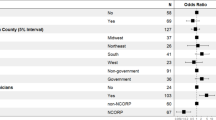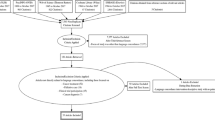Abstract
Documentation of language usage in medical settings could be effective in identifying and addressing language barriers and would improve understanding of health disparities. This study evaluated the availability and accuracy of medical records information on language for 1,664 cancer patients likely to have poor English proficiency. Accuracy was assessed by comparison to language obtained from interview-based research studies. For patients diagnosed at facilities where information on language was not abstracted electronically, 81.6% had language information in their medical records, most often in admissions documents. For all 37 hospitals, agreement between medical records and interview language was 79.3% overall and was greater for those speaking English than another language. Language information is widely available in hospital medical records of cancer patients. However, for the data to be useful for research and reducing language barriers in medical care, the information must be collected in a consistent and accurate manner.
Similar content being viewed by others
References
US Bureau of the Census, American Factfinder. http://factfinder.census.gov/servlet/DatasetMainPageServlet?_program=DEC&_submenuId=datasets_2&_lang=en&_ts=. Accessed Nov 2008.
Ngo-Metzger Q, Massagli MP, Clarridge BR, Manocchia M, Davis R, Lezzoni L, et al. Linguistic and cultural barriers to care: perspectives of Chinese and Vietnamese immigrants. J Gen Intern Med. 2003;18(1):44–52.
Timmins CL. The impact of language barriers on health care of Latinos in the United States: a review of the literature and guidelines for practice. J Midwifery Womens Health. 2002;47(2):80–96.
Cass A, Lowell A, Christie M, Snelling PL, Flack M, Marrnganyin B, et al. Sharing the true stories: improving communication between aboriginal patients and healthcare workers. Med J Aust. 2002;176:466–70.
Elderkin-Thompson V, Silver RC, Waitzkin H. When nurses double as interpreters: a study of Spanish-speaking patients in a US primary care setting. Soc Sci Med. 2001;52(9):1343–58.
Rivadeneyra R, Elderkin-Thompson V, Silver RC, Waitzkin H. Patient centeredness in medical encounters requiring an interpreter. Am J Med. 2000;108:470–4.
Norris WM, Wenrich MD, Nielsen EL, Treece PD, Jackson JC, Curtis JR. Communication about end-of-life care between language-discordant patients and clinicians: insights from medical interpreters. J Palliat Med. 2005;8(5):1016–24.
Committee on Understanding and Eliminating Racial and Ethnic Disparities in Health Care. Unequal treatment: confronting racial and ethnic disparities in health care. Washington, DC: Institute of Medicine; 2003.
Physicians for Human Rights. The right to equal treatment. Washington, DC: Physicians for Human Rights; 2004.
Deyo RA, Diehl AK, Hazuda H, Stern MP. A simple language-based acculturation scale for Mexican Americans: validation and application to health care research. Am J Public Health. 1985;75(1):51–5.
Gomez SL, France AM, Lee MM. Socioeconomic status, immigration/acculturation, and ethnic variations in breast conserving surgery, San Francisco Bay area. Ethn Dis. 2004;14(1):134–40.
Gomez SL, Glaser SL, Kelsey JL, Lee MM, Sidney S. Immigration and acculturation in relation to health and health-related risk factors among specific Asian subgroups in a health maintenance organization. Am J Public Health. 2004;94:1977–84.
O’Malley AS, Kerner J, Johnson AE, Mandelblatt J. Acculturation and breast cancer screening among Hispanic women in New York City. Am J Public Health. 1999;89(2):219–27.
John EM, Phipps AI, Davis A, Koo J. Migration history, acculturation, and breast cancer risk in Hispanic women. Cancer Epidemiol Biomarkers Prev. 2005;14(12):2905–13.
Hasnain-Wynia R, Pierce D, Pittman MA. Who, where, and how: the current state of race, ethnicity, and primary language data collection in hospitals. New York: The Commonwealth Fund; 2004.
Hasnain-Wynia R, Baker DW. Obtaining data on patient race, ethnicity, and primary language in health care organizations: current challenges and proposed solutions. Health Serv Res. 2006;41(4 (Part I)):1501–18.
John EM, Hopper JL, Beck CJ, Knight JA, Neuhausen SL, Senie RT, et al. The breast cancer family registry: an infrastructure for cooperative multinational, interdisciplinary and translational studies of the genetic epidemiology of breast cancer. Breast Cancer Res. 2004;6:R375–89.
John EM, Horn-Ross PL, Koo J. Lifetime physical activity and breast cancer risk in a multiethnic population: the San Francisco Bay area breast cancer study. Cancer Epidemiol Biomarkers Prev. 2003;12(11 Pt 1):1143–52.
Kerlikowske K, Molinaro A, Cha I, Ljung BM, Ernster VL, Stewart K, et al. Characteristics associated with recurrence among women with ductal carcinoma in situ treated by lumpectomy. J Natl Cancer Inst. 2003;95(22):1692–702.
Bloom JR, Stewart SL, Chang S, Banks PJ. Then and now: quality of life of young breast cancer survivors. Psychooncology. 2004;13(3):147–60.
Bloom JR, Stewart SL, Johnston M, Banks P. Intrusiveness of illness and quality of life in young women with breast cancer. Psychooncology. 1998;7(2):89–100.
Horn-Ross PL, John EM, Canchola AJ, Stewart SL, Lee MM. Phytoestrogen intake and endometrial cancer risk. J Natl Cancer Inst. 2003;95(15):1158–64.
Horn-Ross PL, Morris JS, Lee M, West DW, Whittemore AS, McDougall IR, et al. Iodine and thyroid cancer risk among women in a multiethnic population: the Bay area thyroid cancer study. Cancer Epidemiol Biomarkers Prev. 2001;10(9):979–85.
Whittemore AS, Kolonel LN, Wu AH, John EM, Gallagher RP, Howe GR, et al. Prostate cancer in relation to diet, physical activity, and body size in blacks, whites, and Asians in the United States and Canada. J Natl Cancer Inst. 1995;87(9):652–61.
Wrensch M, Lee M, Miike R, Newman B, Barger G, Davis R, et al. Familial and personal medical history of cancer and nervous system conditions among adults with glioma and controls. Am J Epidemiol. 1997;145(7):581–93.
Killoran M, Schlitz MJ, Lewis N. “Unremarkable” recoveries: normalizing adversity and cancer survival. Qual Health Res. 2002;12(2):208–22.
Glaser SL, Clarke CA, Nugent RA, Stearns CB, Dorfman RF. Social class and risk of Hodgkin’s disease in young-adult women in 1988–94. Int J Cancer. 2002;98(1):110–7.
Glaser SL, Clarke CA, Nugent RA, Stearns CB, Dorfman RF. Reproductive risk factors in Hodgkin’s disease in women. Am J Epidemiol. 2003;158:553–63.
Lee MM, Lin SS, Wrensch MR, Adler SR, Eisenberg D. Alternative therapies used by women with breast cancer in four ethnic populations. J Natl Cancer Inst. 2000;92(1):42–7.
Slebos RJ, Hoppin JA, Tolbert PE, Holly EA, Brock JW, Zhang RH, et al. K-ras and p53 in pancreatic cancer: association with medical history, histopathology, and environmental exposures in a population-based study. Cancer Epidemiol Biomarkers Prev. 2000;9(11):1223–32.
Swallen KC, Glaser SL, Stewart SL, West DW, Jenkins CN, McPhee SJ. Accuracy of racial classification of Vietnamese patients in a population-based cancer registry. Ethn Dis. 1998;8(2):218–27.
Swallen KC, West DW, Stewart SL, Glaser SL, Horn-Ross PL. Predictors of misclassification of Hispanic ethnicity in a population-based cancer registry. Ann Epidemiol. 1997;7(3):200–6.
Gomez SL, Glaser SL. Misclassification of race/ethnicity in a population-based cancer registry. Cancer Causes Control. 2006;17:771–81.
Office of Statewide Health Planning and Development (OSHPD). http://www.oshpd.cahwnet.gov/. Annual utilization report of hospitals—2001. Accessed May 2004.
American Hospital Association. AHA guide to the health care field, 1995–96. Chicago, IL: American Hospital Association; 1996.
Baker DW, Hasnain-Wynia R, Kandula NR, Thompson JA, Brown ER. Attitudes toward health care providers, collecting information about patients’ race, ethnicity, and language. Med Care. 2007;45(11):1034–42.
Polednak AP. Collecting information on race, Hispanic ethnicity, and birthplace of cancer patients: policies and practices in Connecticut hospitals. Ethn Dis. 2005;15(1):90–6.
Acknowledgments
The authors thank Patricia Weeks, Sarah Aroner, and Cammie d’Entremont for their contributions to this study. The authors also acknowledge the following researchers for their contributions of patient interview data to this study: J. Bloom, V. Ernster, S. Glaser, E. Holly, P. Horn-Ross, E. John, K. Kerlikowske, M. Lee, M. Schlitz, D. West, A. Whittemore, and M. Wrensch. This study was supported by a grant from the National Cancer Institute’s Surveillance, Epidemiology and End Results (SEER) Rapid Response Surveillance Study under contract N01-PC-35136 awarded to the Northern California Cancer Center. The collection of cancer incidence data used in this study was supported by the California Department of Health Services as part of the statewide cancer reporting program mandated by California Health and Safety Code Sect. 103885, the NCI SEER Program under contract N01-PC-35136 awarded to the Northern California Cancer Center, and the Centers for Disease Control and Prevention’s National Program of Cancer Registries, under agreement #U55/CCR921930-02 awarded to the Public Health Institute. The ideas and opinions expressed herein are those of the authors and endorsement by the State of California, Department of Health Services, the National Cancer Institute, and the Centers for Disease Control and Prevention or their contractors and subcontractors is not intended nor should be inferred. The Breast Cancer Family Registry (Breast CFR) was supported by the National Cancer Institute, National Institutes of Health under RFA-CA-06-503 and through cooperative agreements with members of the Breast CFR and Principal Investigators. This analysis included Breast CFR data collected by the Northern California Cancer Center (U01 CA69417). The content of this manuscript does not necessarily reflect the views or policies of the National Cancer Institute or any of the collaborating centers in the Breast CFR, nor does mention of trade names, commercial products, or organizations imply endorsement by the US Government or the Breast CFR.
Author information
Authors and Affiliations
Corresponding author
Rights and permissions
About this article
Cite this article
McClure, L.A., Glaser, S.L., Shema, S.J. et al. Availability and Accuracy of Medical Record Information on Language Usage of Cancer Patients from a Multi-Ethnic Population. J Immigrant Minority Health 12, 480–488 (2010). https://doi.org/10.1007/s10903-009-9282-3
Published:
Issue Date:
DOI: https://doi.org/10.1007/s10903-009-9282-3




